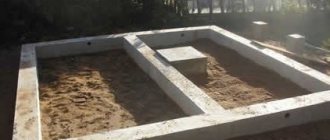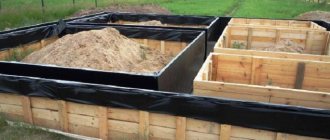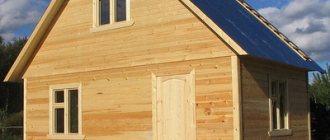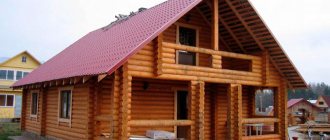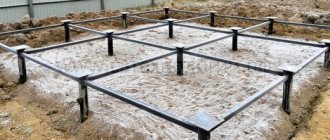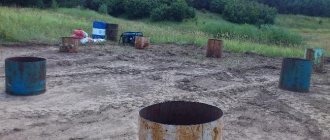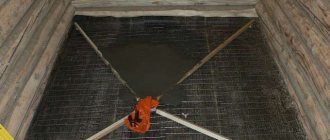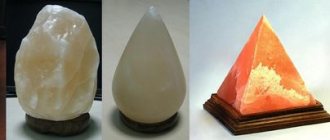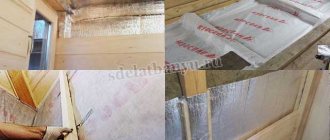Formwork is a structure made of panels, struts and stops, which is used to give concrete and reinforced concrete products their shape. If we talk about construction, this system is necessary when pouring any type of foundation, but the largest structures are needed when installing a strip monolithic foundation. Formwork is also used to create reinforcing belts in masonry walls made of building blocks. In the same buildings, a reinforced belt is often needed at the top to create a solid base for attaching the roofing system. It is also formed using formwork. This design will also be needed when pouring concrete paths or concreting a blind area, and for some other types of work.
Purpose of formwork
The design is designed to prevent liquid material from spreading. Due to the limited space, concrete maintains its given geometry and position in space, dries evenly and acquires the required strength.
Basic requirements for formwork for strip foundations:
- high strength, resistance to the pressure of the liquid mixture inside a given volume and external influences;
- stability of the dimensions of the internal space (the geometry of future base elements);
- the possibility of unhindered pouring of the liquid mixture into the mold, reinforcing the monolithic foundation.
Technical requirements for formwork are collected in GOST 52085-2003, but they relate to industrially used auxiliary structures. For self-installation of formwork, only basic conditions must be met.
Metal tie rods
Hairpin with a diameter of 6 mm. Fastening the formwork
Tie rods
Formwork pins
Installed studs
If you have them, use them for your health; if not, you shouldn’t buy them specifically for the foundation of a bathhouse. It is advisable to use metal studs on high foundations; they cannot be strengthened with side stops. The studs must be inserted into plastic tubes of the appropriate size; be sure to place large diameter washers and pieces of boards under the nuts.
Prices for tie rods
tie rods
Features of different types of structures
There are removable - removed after hardening - and permanent formwork.
Removable formwork for foundation
This name refers to auxiliary structures that are removed after the concrete mixture has gained partial strength. Removable elements consist of panels (solid or plank) and fastening and fixing elements connecting them. If reinforcement is provided (almost always for strip bases), supplies and spacers are added to the standard set to prevent contact of the reinforcement grids with the soil and the inner surface of the pouring forms.
Important: the removal of the formwork occurs before the final curing of the concrete, therefore, when carrying out further work, you should focus on the “maturation” time frame of the foundation, depending on the grade of concrete, weather conditions and the dimensions of the structural elements.
Permanent formwork
Fixed forms are considered to be pouring molds that remain in the building structure after the mixture has cured. This type of structure provides additional strength to the building, its heat, sound and waterproofing properties, and other characteristics. Typically, special blocks made of polystyrene foam, fiberboard and other materials are used as material for permanent structures.
Important: constructing a house using permanent forms significantly speeds up construction, improves the operational characteristics of the building, but at the same time increases the cost of the work.
Polyethylene film
Polyethylene film
Instead, you can take roofing felt, roofing felt, thick wax paper or other materials. The use of these materials for upholstery of formwork panels is encouraged. Why?
- The boards are not thrown away after dismantling the formwork; they can be used during further construction. Of course, except in cases where unnecessary waste was used for formwork, it is easier to immediately cover it with earth. Lumber from formwork can be used during the construction of subfloors and ceilings; in these cases, it is only necessary to clear the surfaces of large concrete residues. If high-quality lumber was used for formwork, then their use is not limited only to auxiliary structures. But there is one problem - no self-respecting craftsman will put such boards through a surface planer - sand and dirt will instantly dull the cutting knives.
Sheathing the formwork with parchment or film
Polyethylene film perfectly protects the formwork surfaces from contamination. And not only in direct contact with the concrete, but also on the opposite side. It will not be possible to knock down the boards perfectly tightly (and it is not necessary), and the liquid fraction of concrete will always seep through small cracks and stain the boards on the back side.
- The presence of polyethylene greatly facilitates and speeds up the dismantling of formwork and minimizes the risk of compromising the integrity of foundation surfaces in the event of premature dismantling.
It is much easier to dismantle formwork with film
The film must be installed on the inside of the formwork. To prevent sagging or slipping, secure it with a stapler.
Prices for polyethylene film
polyethylene film
Calculation of formwork for the foundation
In this case, calculation means the calculation of the required thickness of the boards or boards of the structure, taking into account the distance between the supports, the specific gravity of the mixture being poured and the resistance ability of the mold material. The traditional, simplest formwork design consists of panels installed at the bottom of a pre-dug trench, held in a vertical position by special supports.
The choice between stakes or braces depends on the volume of the mixture being poured and the type of soil: for small foundation strips (250...400 mm) and dense soil that is not prone to shedding or sliding, stakes are sufficient. If in doubt, it is better to give preference to braces, since they are able to hold the panels in place even with increased load.
Formula for calculating the thickness of shields (minimum)
h = √((0.75×G×n×l^2)÷T)
Here
- G is the load of the liquid mixture on the formwork, it is assumed to be maximum and is defined as the product of the specific weight of concrete and the thickness of the poured layer G = qx H. The specific gravity is q = 2500 kg/m3, H is the height of the foundation strip in meters;
- n is the compaction coefficient of the concrete mixture. If vibration compaction is not used, the coefficient is equal to one;
- l – distance between shield supports, in meters;
- T – load resistance of the board material; for wood it is assumed to be 8 x 105 kg/sq.m.
Taking into account the difficulty of independently determining the grade of concrete, respectively, its density, as well as the lack of accurate data on the resistance of the material of formwork panels, calculations are carried out approximately, for average values. Typically, the thickness of the board is taken to be 25 mm.
The second part of the calculation is determining the required number of boards of a given thickness and the number of fasteners. For these calculations, it is necessary to know the length of the foundation strip and the height of the fill. The length of the tape is multiplied by two, since the shields are located on both sides. When installing a strip foundation with a step, the calculation is carried out twice - for the first and second stages of pouring. The amount of lumber is determined based on the data on which board for the foundation formwork will be used (dimensions).
Drawing up a plan similar to that shown in the illustration will help you navigate a more accurate calculation of the required length of the form, the number of connecting and supporting parts.
Do-it-yourself formwork for a strip foundation
In order to correctly form the base of the building, it is necessary to correctly install the base for pouring. We will analyze two design options, based on removable wooden and permanent foam formwork.
Regardless of what type of form is used, part of the work performed is carried out according to a single scheme.
- Site marking. It is done using stretched cords or fishing line (in the illustration “cast-off strings”) according to the building construction plan.
- Digging a trench. In this case, it is necessary to dig out a ditch according to the depth of the future foundation, taking into account the cushion under the foundation and the depth of soil freezing (you can read in more detail about the principles of constructing a foundation and preparing a place for it in the article). Since creating strictly vertical walls is practically impossible, they try to create a slope with a minimum slope, about 15...30 degrees to the vertical.
- Compaction of soil at the bottom and walls of the ditch. Tamping is done manually or using special mechanisms. This process is especially important for loose soils. Tamping can be replaced by the use of geotextiles - a special material that prevents soil shedding.
- Creating a foundation cushion. For it, sand of large (1...3 mm) fractions, fine crushed stone or granots, pre-washed and dried, is used. To enhance the load-bearing capacity of the base, the cushion is poured with a liquid cement mixture; in especially critical cases, concreting is performed.
- The formwork is being installed. Slots and gaps between structural elements should not exceed 2 mm, the strength of the structure should correspond to the required one, taking into account the thickness of the poured layer.
- The fittings are being installed. The installation of rod systems and meshes is planned with the obligatory preservation of the protective layer of concrete from the metal to the external environment. You can read more about the rules for tying reinforcement and its protection against corrosion in the feature article.
- Pouring concrete mixture.
- Vibration compaction (if possible).
Depending on what type of forms is used, the nuances of the technological process of installing the formwork and, in the removable version, its removal change.
Installation of formwork from boards or plywood
Due to the successful combination of load characteristics and price, edged boards for foundation formwork are the most popular and popular option. The wood used is water-resistant species (pine, alder, birch) with an initial moisture content of 18...25%. Boards made from boards are assembled using bars on nails or self-tapping screws. In this case, the points of the fasteners should extend to the outer (facing the ground) side of the boards.
The knocked down panels are installed on the prepared cushion, reinforced with braces or stakes with a pitch of 800...1000 mm. To prevent the structure from spreading under the weight of the poured mixture, the opposite panels are connected by spacers.
As an option, first a box is mounted on the base of shields and cross braces, after which the finished structure is laid in a trench and fixed with stakes.
Important: there should be no gaps between the boards! Otherwise, the solution will begin to flow into the gaps, and the consumption of concrete will noticeably increase. Possible formation of voids inside the poured form, violation of the strength calculations of the foundation.
Proper formwork can easily withstand the pouring of concrete mixture and is easily separated from the hardened base after initial curing. The period for stripping (removing formwork), depending on temperature and humidity conditions, is 8…20 days. At subzero temperatures, it is undesirable to disassemble the form-building structure, since the time it takes for concrete to gain design strength slows down in proportion to the decrease in temperature.
How to assemble formwork for a foundation from foam blocks or panels
Industrially produced foam blocks or panels are manufactured with their own tongue-and-groove fastening system. Thanks to this, connecting the elements of the future form is not difficult:
- the first row is laid according to the markings so that the line is perfectly straight;
- the second and subsequent rows are mounted taking into account the location of the reinforcing bars - they must pass strictly through the cavities in the blocks. For panel options, displacement is allowed;
- concrete is poured only by hand, after installing every three to four rows of foam blocks.
Important: low-quality (crumbling, irregularly shaped) blocks are only suitable for low-impact buildings with low loads.
If you want to create permanent formwork with your own hands, you should choose the option with a two-layer structure. The outer layer is a sheet material that defines the geometry (as is the case with removable formwork), the inner layer is sheets of foam plastic or expanded polystyrene. Concrete is poured into the cavity between the internal heat-insulating layers, which are not subsequently removed. The outer layer is dismantled after the mixture has cured.
Plywood
This is a wood-laminated material that can be made from veneers of different types of wood. If finances allow, it is better to choose Finnish plywood; it is characterized by increased moisture resistance and strength. A cheaper option is birch veneer plywood.
Healthy! Also on sale are plywood coated with synthetic impregnations, formaldehyde glue (such products are labeled as FSF) and a protective laminated layer. These are specialized materials that are used for the construction of dismountable formwork structures that can be reused.
The optimal plywood thickness should be 10-16 mm. Such sheets are installed on a wooden (some use metal) frame made of 40 x 40 mm bars. The plywood is fixed using self-tapping screws.
Nuances of formwork installation for different types of foundations
In low-rise private construction, a strip base is the most common option. However, he is not the only one. Slab and columnar foundations are also used.
Formwork for columnar foundations
In this case, in addition to the general trench, deep holes are dug for columnar supports. They are located along the perimeter of the future building so that there is a support at each corner or intersection of the walls.
The formwork itself is also made from boards, plywood or other sheet materials using the technology described above. The difference is the arrangement of the limiting elements in the form of a vertically located tetrahedral prism (a column of rectangular or square cross-section) or a cylinder. Filling is done from above. Reinforcement of a columnar foundation is carried out separately for each support, followed by piping.
In this case, the column has either the same cross-section throughout its entire height, or an enlarged lower step.
It is mandatory to place a cushion under the foundation supports; the lower step can be poured into the ground without formwork, but at the same time reinforced. Formwork is installed for the upper part of the support, and the reinforcement of the upper and lower parts is tied together. Supports that are simple in shape and have a limited load can be concreted without reinforcement.
If it is planned to install a monolithic grillage on top of a columnar foundation, the formwork for it is carried out separately, in the form of a box.
Formwork for foundation slab
The main difference between this type of limiter is its one-sided arrangement: the shields outline the shape of the future slab along the outer sides.
Important: when installing this type of formwork, you should be more careful when calculating the strength of the structure, since the load on the panel stops increases in proportion to the size of the slab.
Foam blocks are not used as permanent formwork for slab foundations. If it is necessary to make the limiters non-removable and at the same time use them to insulate the base, use flat sheets of foam or polystyrene.
Tree
This is the most common and accessible material. As a rule, so-called type-setting boards are assembled from boards, which are fastened with bars 60 x 40 or 80 x 40 mm. The wood species can be any.
Healthy! It is recommended to use edged boards. Otherwise, after concrete is poured, it will begin to ooze through the formwork.
The boards themselves allow you to create formwork structures of any height. However, if the height of the base exceeds 1.5 meters, it is recommended to use materials with a thickness of at least 40 mm. The cross-section of the connecting bars must be at least 50 x 100 mm. Otherwise, wooden panels may not withstand the onslaught of the cement-sand mass. For a lower foundation, boards 20-30 cm thick are suitable.
As a rule, in order to create a more airtight structure, the boards are overlapped and fixed with self-tapping screws or nails, the length of which should be ¾ of the thickness of the boards and bars.
The main disadvantage of such formwork is that it is usually used only once. After this, the wooden panels are broken and dismantled.
